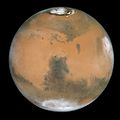Ficheiro:Mars and Syrtis Major - GPN-2000-000923.jpg

Dimensões desta antevisão: 600 × 600 píxeis. Outras resoluções: 240 × 240 píxeis | 480 × 480 píxeis | 1 023 × 1 023 píxeis.
Imagem numa resolução maior (1 023 × 1 023 píxeis, tamanho: 104 kB, tipo MIME: image/jpeg)
Histórico do ficheiro
Clique uma data e hora para ver o ficheiro tal como ele se encontrava nessa altura.
| Data e hora | Miniatura | Dimensões | Utilizador | Comentário | |
|---|---|---|---|---|---|
| atual | 22h57min de 17 de junho de 2012 |  | 1 023 × 1 023 (104 kB) | Tomruen | {{Information |Description ={{en|1=Mars Near Opposition 1995-2005: 1999 }} |Source =Replace with 2005 release: http://hubblesite.org/newscenter/archive/releases/solar%20system/mars/2005/34/image/h/ |Author =NASA |Date =2005... |
| 00h52min de 9 de abril de 2009 |  | 800 × 800 (227 kB) | BotMultichillT | {{Information |Description={{en|1=Taking advantage of Mars's closest approach to Earth in eight years, astronomers using NASA's Hubble Space Telescope have taken the space-based observatory's sharpest views yet of the Red Planet. The telescope's Wide Fi |
Utilização local do ficheiro
A seguinte página usa este ficheiro:
Utilização global do ficheiro
As seguintes wikis usam este ficheiro:
- ar.wikipedia.org
- ca.wikipedia.org
- en.wikipedia.org
- Portal:Technology/Selected articles
- Portal:Technology/Selected articles/38
- History of Mars observation
- Portal:Outer space/Selected article
- Glossary of astronomy
- Portal:Outer space/Selected article/31
- Wikipedia:Today's featured article/January 2013
- Wikipedia:Today's featured article/January 8, 2013
- Wikipedia:Main Page history/2013 January 8
- es.wikipedia.org
- fi.wikipedia.org
- fr.wikipedia.org
- he.wikipedia.org
- id.wikipedia.org
- ja.wikipedia.org
- mwl.wikipedia.org
- os.wikipedia.org
- ru.wikipedia.org
- uk.wikipedia.org
- ur.wikipedia.org
- zh.wikipedia.org

